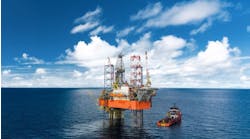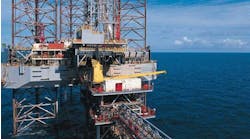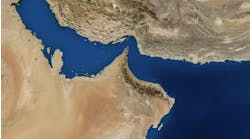James C. DayMarketing commodity products, offshore drilling equipment, within a commodity-driven industry has developed many skeptics about its eventual recovery, given the many false starts that have occurred. However, the fundamentals for the sector over the next decade appear to be quite positive; perhaps the most favorable since the late 70s. Supported by strength in the commodity prices and increasing focus on deepwater development, mobile offshore drilling utilization has remained quite robust for months. While the tightness in the market has precipitated much speculation as to what may evolve, continued strengthening and stabilization of dayrates will be required for a significant newbuild program to be initiated.
Chairman, Chief Executive Officer and President;
Noble Drilling Corporation
The supply imbalance created in the early 1980s peaked at 811 units in March 1985. Through attrition, this surplus has been diminishing and currently stands at 641 rigs worldwide. In fact, of the marketable rigs, utilization is effectively at 100%. Out of 61 units not contracted as of late July, no semisubmersibles and only seven jackups were actually in a stacked ready mode. This strong market should continue for the intermediate term, assuming that gas and oil demand should remain strong.
Economic growth fueled by oil and gas demand
Leading the way for increased offshore exploration and production, is the rising commodity demand. The demand for oil and gas worldwide has been steadily increasing since 1994 as the global economy improves. This trend should continue as the North America and Europe economies expand and will be further supported by high growth rates in the Asia/Pacific and Latin America regions.
As the international markets have tightened up, it has lessened the units available to the Gulf of Mexico which further stabilizes the demand/supply ratio worldwide. Low storage levels for natural gas coupled with short well lives has put further pressure on operators to continue active drilling plans.
Prolific deepwater reserves targeted to meet demand
Steady decline in oil reserves has prompted operators to focus on high deliverability areas to match increasing production demand and to replace reserves. Prolific deep water drilling has been further encouraged by legislative support. The Deep Water Royalty Relief Act which was passed into law in November 1995 is designed to provide incremental royalty relief to encourage production in deep waters of the OCS of the US Gulf. The royalty relief temporarily eliminates royalties on production from new leases for blocks in 650 ft of water and greater.
The Royalty Relief Act has already initiated a boost in US Gulf activity as Lease Sale No. 157 in April recorded a record breaking sale of 1,381 bids on 924 tracts. Additionally, there are 1,217 leases expiring by 2001 which is causing operators to attempt to "lock-in" drilling units. In the April lease sale, over 40% of the leases bid were in water depths beyond 2,700 ft indicating the favorable response brought about by the Royalty Relief Act. As this trend in the US Gulf continues to escalate, it will put even more pressure on the other mature producing areas of the world as competition for rigs continues.
Conversion and reactivation of drilling units continues at a rapid pace
As dayrates have risen to levels to provide reasonable rates of return, plans are being made by contract drillers to refurbish and activate cold-stacked units. This is the first sign that the imbalance created over 15 years ago has finally reached an end.
The economics for the refurbishments, while not being overly attractive, can provide a reasonable return assuming five years or more of sustained utilization. This favorable economic environment applies to both jackup and semisubmersible units, for moderate upgrades or conversions where the unit has not been idle for an extended period. Conversion and reactivation has already begun for the majority of these units including 18 semisubmersibles, 14 jackups, and five drillships with plans for several more. However, of the units currently not contracted, almost half are not suited, due to age or design, for refurbishment. For the remaining units, the decisions become more difficult as the upgrade costs approach that of newbuilds.
Newbuild construction should be delayed until economic justification
As we're all painfully aware, our industry is highly cyclical in nature and although we are experiencing early indications of an upswing, we have seen the effects that result from speculative overreaction to market trends. Improvements in dayrates still have a long way to go before justifying newbuild of jackup and semisubmersible assets estimated at between 100% to 300% from current levels. Since 1986, there have only been 19 semisubmersible and 23 jackups delivered. At present, there are eight mobile rigs under construction comprised of three jackups, three semisubmersibles, and two drillships, four of which are owner operated. These newbuilds either have commitments or commitments are anticipated during the construction phases.
Assuming a 1% attrition in the worldwide jackup for 250-ft water depth independent leg cantilever units, coupled with a 2% increase in demand, construction activity should begin in two years. We anticipate two units/yr would meet demand. Certainly this new building phase will be focused on designs that are obviously efficient from an operating perspective, but also easier to construct. The inefficiencies eliminated from the industry in the 80s will not be ignored by the prudent.
The major drilling contractors are more capable than we were in the early 1980s; hopefully, as we prepare for the future, newbuild construction will occur at a rate which can reasonably respond to market demands but eliminate the speculative excesses that destroyed the industry for a decade.
This page reflects viewpoints on the political, economic, cultural, technological, and environmental issues that will shape the future of our industry. Offshore Magazine invites you to share your thoughts. Send your manuscript to Beyond the Horizon, Offshore Magazine, Box 1941, Houston, TX 77251 USA. Manuscripts will not be returned.
Copyright 1996 Offshore. All Rights Reserved.


